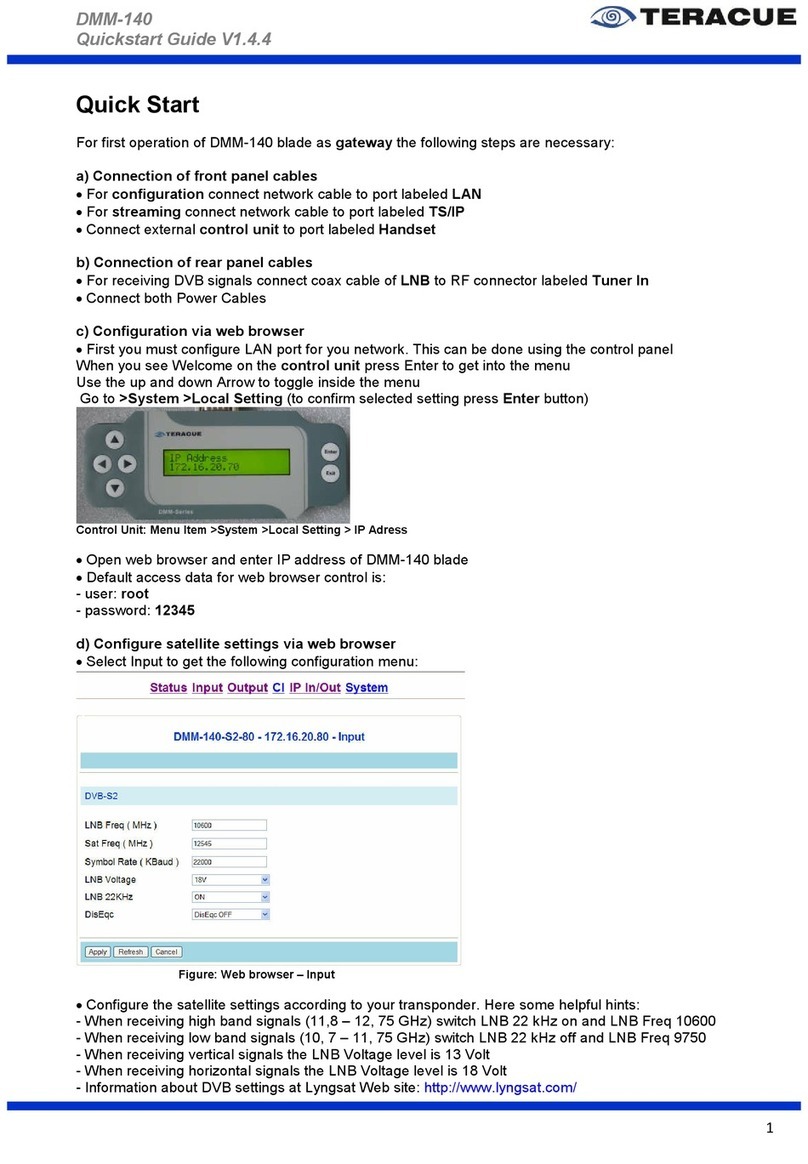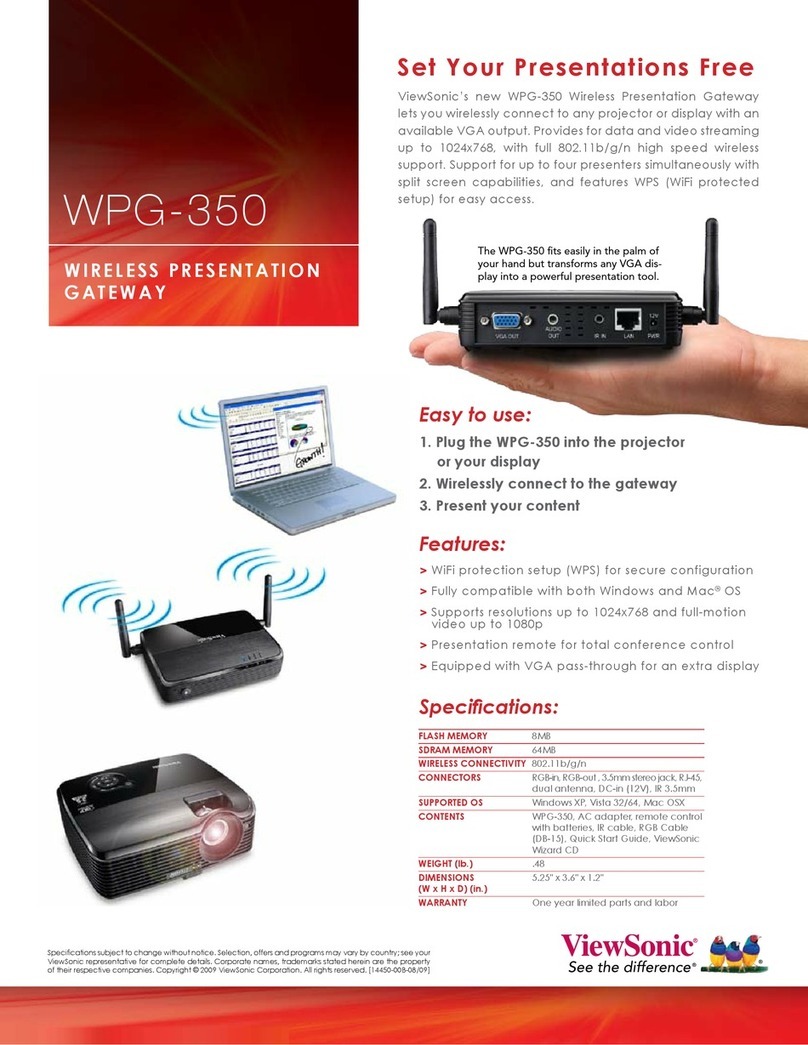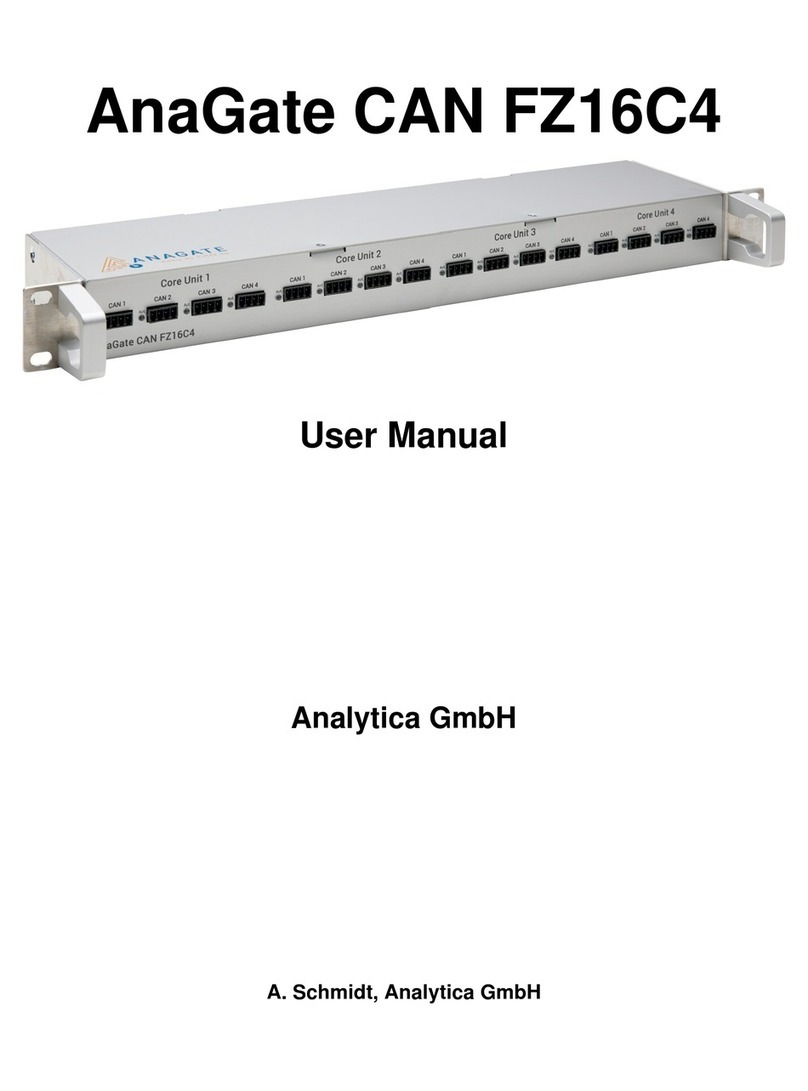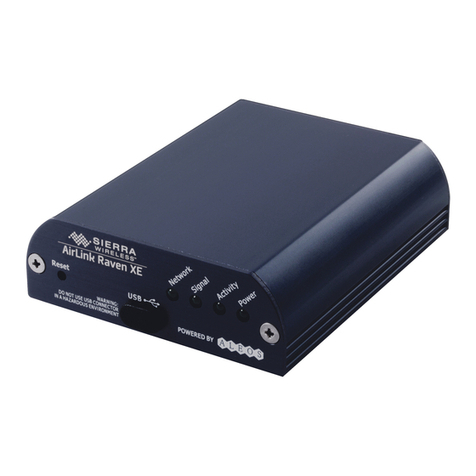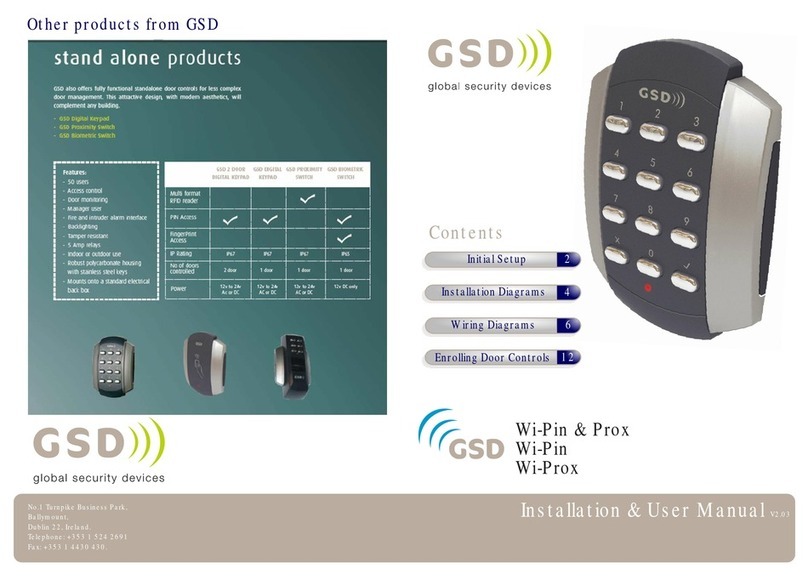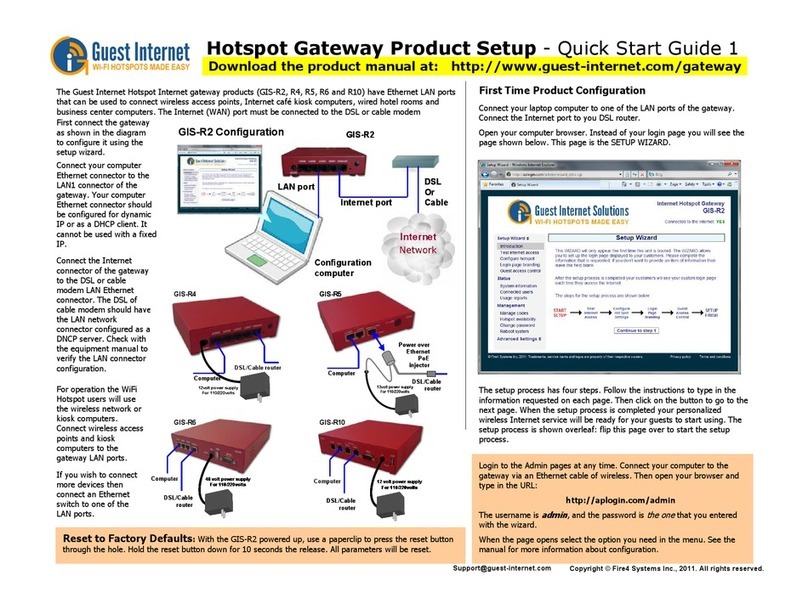Teracue DMM-Series User manual

DMM-Series
User Guide V1.2
1
D
DM
MM
M-
-S
S
E
ER
RI
IE
ES
S
User Guide V1.1
Teracue eyevis GmbH
Schlossstr. 18
85235 Odelzhausen
Germany
Tel: +49 (0)8134-555-10
Fax: +49 (0)8134-555-199
www.teracue.com
Document Version 1.2/141113

DMM-Series
User Guide V1.2
2

DMM-Series
User Guide V1.2
3
C
OPYRIGHT
This document may not be reproduced in any form, in whole or in part, without
the prior permission of Teracue eyevis GmbH.
Copyright © 2014 by Teracue eyevis GmbH, all rights reserved.
D
ISCLAIMER
This publication supersedes all previous publications.
Information and specification in this documentation is subject to change
without notice. Please make sure you have the latest document version.
Documents are located at: www.teracue.com/support
If you find some points in this document unclear then please let us know, so
we can improve this documentation.
All information within this document is confidential to Teracue eyevis GmbH
costumers and should not be copied or distributed to non Teracue eyevis
GmbH customers.
T
RADEMARKS
All Teracue products and all of its components are registered trademarks
licensed to Teracue eyevis GmbH.
All other logos and trademarks both marked and not, may be trademarks or
registered trademarks and therefore property of their respective owners.

DMM-Series
User Guide V1.2
4
I. Information about the manual
This manual is designed to help administrators and users to install the DMM-Series on
their computer.
If you received this publication as a PDF, then it's a good idea to print it out for future reference.
It is best to use this user guide directly in front of your computer, by doing so you try out everything at
once.
.!. Important features are marked by this sign.

DMM-Series
User Guide V1.2
5
II. Content
1.
OVERVIEW...................................................................................................................................... 6
1.1
C
HARACTERISTICS
..................................................................................................................... 6
1.2
M
AIN
F
EATURE
.......................................................................................................................... 6
1.3
DMM-100
M
AIN
C
HASSIS
.......................................................................................................... 6
1.4
DMM-100
CU
H
ANDHELD
P
ROGRAMMER
U
NIT
........................................................................... 6
1.5
DMM-140
S
ERIES
P
ROFESSIONAL
MPEG-2
SD
IRD
AND
P
ROCESSOR
M
ODULE
......................... 7
1.6
DMM-150
S
ERIES
P
ROFESSIONAL
M
ULTI
-
FORMAT
HD/SD
IRD
AND
P
ROCESSOR
M
ODULE
.......... 7
2.
CONTROL WITH DISPLAY AND KEYPAD.................................................................................... 8
2.1
DMM-150
S
ERIES
..................................................................................................................... 8
2.2
DMM-140
S
ERIES
................................................................................................................... 11
3.
CONTROL WITH WEB SERVER.................................................................................................. 14
3.1
DMM-150
D
ECODER
M
ODULE
................................................................................................. 14
3.1.1
Status Menu....................................................................................................................... 14
3.1.2
Tuner ................................................................................................................................. 15
3.1.3
CI ....................................................................................................................................... 16
3.1.4
Decoder ............................................................................................................................. 17
3.1.4.1
Audio.......................................................................................................................... 17
3.1.4.2
Video.......................................................................................................................... 18
3.1.4.3
Decoder Play............................................................................................................. 19
3.1.5
Output................................................................................................................................ 20
3.1.6
BISS................................................................................................................................... 20
3.1.7
MUX................................................................................................................................... 21
3.1.8
IP Out................................................................................................................................. 21
3.1.9
IP In ................................................................................................................................... 24
3.1.10
Backup........................................................................................................................... 25
3.1.11
System........................................................................................................................... 26
3.1.11.1
Device....................................................................................................................... 26
3.1.11.2
Version...................................................................................................................... 26
3.1.11.3
Network..................................................................................................................... 27
3.2
DMM-140
D
ECODER
M
ODULE
................................................................................................. 28
3.2.1
Status Menu....................................................................................................................... 28
3.2.2
Input Menu......................................................................................................................... 29
3.2.3
Output Menu...................................................................................................................... 29
3.2.3.1
ASI Output ................................................................................................................. 29
3.2.3.2
ASI2/SDI.................................................................................................................... 30
3.2.3.3
Decoder Play............................................................................................................. 30
3.2.3.4
Decoder Config.......................................................................................................... 31
3.2.4
CI ....................................................................................................................................... 32
3.2.5
IP Out................................................................................................................................. 33
3.2.6
IP In ................................................................................................................................... 36
3.2.7
System............................................................................................................................... 37
4.
TECHNICAL SPECIFICATION...................................................................................................... 39
4.1
DMM-140
S
ERIES
................................................................................................................... 39
4.2
DMM-150
S
ERIES
................................................................................................................... 41
5.
FAQ................................................................................................................................................ 43
5.1
W
HAT IS A
“
GOOD
”
INPUT SIGNAL FOR SATELLITE RECEPTION
?.................................................... 43
6.
STATEMENT OF CONFORMITY DMM-140-SERIES................................................................... 44
7.
STATEMENT OF CONFORMITY DMM-150-SERIES................................................................... 45

DMM-Series
User Guide V1.2
6
1. Overview
1.1 Characteristics
DMM-Series is a compact modular digital TV head end that includes professional MPEG-2 and H.264
SD/HD IRD, MPEG-2 and H.264 SD/HD, Re-Multiplexer, QAM/COFDM Trans-Modulator, DVB
Scrambler. Within 19” 4RU chassis, it provides 8 slots for any type of modules with redundant power
supply. Also available 19” 1RU chassis for 2 slots with single power supply. With flexible solution and
the high density, DMM-100 offers operators the advanced head end architectures in the marketplace
for delivering analog and digital broadcast services to their subscribers. Coming with more new
modules, DMM-100 is most suitable for future multiple network architectures: streaming and
multiplexing of digital content over IP based networks and conversion of digital content for analog
networks.
1.2 Main Feature
DVB-S2/S, DVB-S, DVB-C, DVB-T2/T IRD modules with CI
DVB-S/S2T/T2 to DVB-C QAM and DVB-T COFDM trans-modulator module
8 Way re-multiplexer module
DVB Simulcrypt, BISS-1, BISS-E scrambler module
Rich interface with ASI, IP, SDI, YPbPr, CVBS, XLR
Web, SNMP Remote Control or handheld programmer unit local control
4RU 19” chassis compact modular design, supporting up to 8 modules with redundant power
supply.
1RU 19” chassis compact modular design, supporting up to 2 modules with single power supply
Functional module hot-swappable
Intelligent cooling system
Stand alone function of each module
Cost-saving by backward compatible with new modules
On site software update through IP
1.3 DMM-100 Main Chassis
Standard 19” 4RU chassis with 8 slots for functional modules and 2 slots for power supplies
Hot-swappable power supply unit
Intelligent cooling system
Wall mounted or Rack mounted
Backward compatible with new modules
Power Supply: AC 100V-260V, 50-60Hz
Optional Build-in IP Switch
19” 1RU chassis with 2 slots and single power supply
Dimension: L: 40,3 cm, W: 48,3 cm, H: 17,5 cm
1.4 DMM-100 CU Handheld Programmer Unit
2 x 20 LCD display screen and 6-key keypad
No external power or battery needed
Easy and quick on site system configuration without PC
Backward compatible with new modules
Dimension: L: 17,0 cm, W: 7,5 cm, H: 2,1 cm

DMM-Series
User Guide V1.2
7
1.5 DMM-140 Series
Professional MPEG-2 SD IRD and Processor Module
Multiple inputs DVB-S2/S/C/T, TS/IP and ASI
SD MPEG-2 MP@ML digital video decoding
Flexible built-in re-multiplexing between ASI, Tuner and TS/IP Inputs
2x DVB-CI slots, multi programs, BISS-1 and BISS-E decryption
Dynamic PMT detection and automatic updating
UDP, RTP Multicast / Unicast IP output, supports up to 32 independent channels
PCM audio embedded in SDI output
Remote control and supervision by SNMP, HTTP WEB and proprietary HDMS software
RSSI, received Eb/No & BER monitoring
On Site software update through IP
1.6 DMM-150 Series
Professional Multi-format HD/SD IRD and Processor Module
Multiple inputs DVB-T2/S2/S/C/T/T2, TS/IP and ASI
Redundant inputs between tuner, ASI and TS/IP
SD/HD MPEG-2 and H.264 digital video decoding
Digital audio decoding and loop through via SDI, HDMI and AES-EBU
Multiple analog and digital outputs, ASI, CVBS, YPbPr, HDMI, SD/HD-SDI, TS/IP
Flexible re-multiplexing between 2xASI, tuner and TS/IP Inputs
2x DVB-CI slots, multi programs, BISS 1 and BISS E decryption
Dynamic PMT detection and automatic updating
Support VBI TELETEXT, EBU/ DVB subtitle, closed caption
UDP/RTP & Unicast/Multicast SPTS and MPTS over IP I/O
Remote control and supervision by SNMP, HTTP WEB and proprietary HDMS software
PCM audio embedded in SDI output or PCM audio over HDMI
PCM output on two AES/EBU output ports
On Site software update through IP
RSSI, received Eb/No & BER monitoring

DMM-Series
User Guide V1.2
8
2. Control with Display and Keypad
2.1 DMM-150 Series
Main-Menu Sub-Menu Description
Inputs
Status ASI: Display ASI input status
TUNER: Display tuner input status
IP IN: Display IP input status
DVB-S2
LNB Frequency: Input LNB frequency
Satellite Frequency: Input downstream frequency of satellite
Symbol Rate: Input symbol rate of satellite
LNB Voltage: Off/13V/18 V
LNB 22KHz: 22KHz or Off.
DISQEC: Port A/Port B/Port C/Port D/DiSEQC OFF
PLS Gold Code: 0~5000
Frequency Offset High: 5000KHz
Frequency Offset Low: -5000KHz
QAM Constellation: 16/32/64/128/256QAM/64B/256B
Frequency: Enter the frequency of the QAM signal in MHz.
Symbol Rate: Edit the symbol rate to the proper value in kBaud.
COFDM Frequency: Input terrestrial frequency.
Bandwidth: select bandwidth from 6MHz, 7 MHz and 8 MHz.
RSSI Tuner Status: Display tuner status
Strength Display: Display the strength of tuner signal
Ethernet
Stream IP Addr: 1.0.0.1~223.255.255.254
Stream Netmask: 1.0.0.1~223.255.255.254 and 0.0.0.0
Stream Gateway: 1.0.0.1~223.255.255.254 and
224.0.0.0~239.255.255.255
Stream Mac Address: Display MAC address
Multicast IP Addr: Enter the IP address of the multicast stream
for the transport stream over IP.
Multicast UDP Port: Enter the UDP port number of the TS over
IP stream.
Protocol: UDP/RTP.
Output Smoothing:
Auto: the bit rate is variable.
Disable: the unit let the TS pass by.
Fixed Rate: the bit rate is fixed.
TS Bit Rate: sets the bit rate of the TS which comes from
the TS/IP input. The setting is only valid when the output
smoothing is configured as Fixed Rate.

DMM-Series
User Guide V1.2
9
Main-Menu Sub-Menu Description
Outputs
BISS Menu
Biss Mode: Set Biss mode, can select ‘OFF’, ‘Biss E’ or ‘Biss 1’
Biss 1 Setup: Set Biss 1 (password is required)
Biss E Setup: Set Biss E (ID number and password are required)
Biss Source: Tuner/ASI Input
CI CI Source: MUX TS/Tuner/ASI Input
Setup: Select TS
CAM Name: Display CAM name of CI Slot1 and Slot2
Decoder
Status: Show Status
Source: CI De-encrypted/TUNER/ASI Input/Mux TS
Program: Select programs.
Video
Video Standard: Select from Auto/1920x1080i
30/1920x1080i 29.97/1920x1080i 25/1280x720p
60/1280x720p 59.97/1280x720p 50/720x480p
59.94/720x480p 60/720x576p 50/720x576p 25/720x480i
29.97/720x576i 25
Screen: Select from Auto, 4:3 Full, 4:3 Letterbox, 16:9
Letterbox or 16:9 Full.
DVB subtitle language: Choose DVB Subtitle language.
EBU subtitle language: Choose EBU Subtitle language.
Subtitle Priority: Select from DVB First or EBU First.
Fail Mode: Select from Black Screen, No Sync and Still
Picture.
VBI Mode: Disable/Enable. VBI option only controls Closed
– Caption over CVBS. To activate the CC over CVBS,
enable the VBI option.
Close Caption: Off/On. Controls both CC on CVBS and
SDI.
CVBS Sub PAL: select PAL mode, including PAL-
B/D/G/H/I, PAL-N, PAL-N_C and SECAM.
CVBS Sub NTSC: select NTSC Mode, including NTSC-M,
NTSC-M_J, NTSC-M_443 and PAL-M.
Note: the sub-menus VBI Mode, CVBS Sub PAL and CVBS Sub
NTSC will only show up when the Closed Caption option is on.
Audio
Audio Level: 0~99.
Audio Mode: select Stereo, Left, Right or Mono for
soundtracks.
Audio Priority: select the priority of the audio.
Mode: select from Manual Selection and First Service. First
Service means to select the program no. automatically, normally
the first program in the TS. Manual Selection means to select
the program manually.
ASI1/2 ASI1/2 Source: CI De-encrypted/TUNER/ASI Input/Mux TS
SDI
Embedded Audios: On and Off.
Closed Caption Mode: select from SMPTE 708, SMPTE 608,
Line 21, and Auto. The mode of closed caption needs to be
selected based on the video resolution. SMPTE 708 and SMPTE
608 are more suitable for HD video; SMPTE 608 and Line 21 are
for SD. When select Auto, the unit will choose SMPTE 608 for
HD video, and Line 21 for SD video.
Note: Before doing the setup, be sure to enable the Closed
Caption switch in the menu Decoder- Video.
Mux
Mux Switch: On/Off
Bit Rate: should be set to a specified value that doesn’t exceed
the max physical limit of the output medium. For example, to
deliver the multiplexed TS to an 8MHz DVB 256QAM modulator,
it should not exceed 55000Kb/s, otherwise overflow occurs.

DMM-Series
User Guide V1.2
10
TS ID: 1~65535
Program List: Select program.
Output Bit Rate: Display Output bit rate
Ethernet
Stream IP Addr: 1.0.0.1~223.255.255.254
Stream Netmask: 1.0.0.1~223.255.255.254 and 0.0.0.0
Stream Gateway: 1.0.0.1~223.255.255.254 and
224.0.0.0~239.255.255.255
Stream Mac address: Display factory-Set Mac addresses
Gateway Mac address: Edit Gateway Mac address
Multicast IP Addr: Enter the IP address of the Multicast Stream
for the transport Stream over IP.
Multicast UDP Port: Enter the UDP Port number of the TS over
IP stream.
Protocol: UDP/RTP
TS Pkts Per UDP: 1~7
Time to live: 1~255
Type Of Service: Min Delay/Max Reliability/Max Throughput/Min
Monetary Cost/Normal
Source: Tuner/ASI input/Mux TS/CI De-encrypted
Mode: IPTV/DVB
Uni-/Multicast Setup
Max Channels: 1~32
Channel 0~31
Switch: On/Off. Enable or disable the channel.
Multicast IP Address: 224.0.0.0 ~ 239.255.255.255
*(When using Unicast, the Multicast IP Address should be
set as the IP address of the receiving device.)
Multicast UDP Port: 1~65535
Target MAC Address: Edit Target MAC Address
Program List: Select program
Backup
Main channel: ASI/Tuner.
Backup channel: ASI/Tuner.
Main CH Unlock Time: set Main CH Unlock Time, ranging from 0
to 59 seconds. When signal of the main channel remains the
disconnected status over this value, the unit will switch to the
backup channel automatically.
Main CH Recover Time: set Main CH Recover Time, ranging
from 0 to 59 seconds. When the signal of the main channel
recovers and remains stable over this value, the unit will switch
back to the main channel.
Local Setup
IP Address: 1.0.0.1~223.255.255.254
Netmask: 1.0.0.1~223.255.255.254 and 0.0.0.0
Gateway: 1.0.0.1~223.255.255.254 and
224.0.0.0~239.255.255.255
MAC Address: Display MAC Address
Trap IP Addr Trap IP Addr
Unit Name Unit Name
Properties
Main Version
Linux OS Version
ARM S/W Version
Decoder Version
FPGA Version
TS/IP Out NIOS
TS/IP Out FPGA
Factory Setting Enter: Yes, Exit: No
Optional
Function
External Board Type: 100M Single In/100M Single Out/No Exist
Mux Function: Enable/Disable
Filter Function: Select from Disable/Filter/Mux.
HTTP Login Modify the username and password for the WEB management.

DMM-Series
User Guide V1.2
11
2.2 DMM-140 Series
Main-Menu Sub-Menu Description
Inputs
Status ASI: Display ASI input status
TUNER: Display tuner input status
IP IN: Display IP input status
QPSK
LNB Local Oscillator (L.O.) Freq: enter the frequency of the LNB
in MHz.
Satellite Freq: edit the satellite down link frequency in MHz. The
IF frequency will be calculated automatically.
Symbol Rate: enter the QPSK symbol rate.
LNB Voltage: Off/13 V/18 V
LNB 22KHz: On/Off
DiSEQC: Port A/Port B/Port C/Port D/DiSEQC OFF
COFDM Frequency: enter the proper frequency of the COFDM signal in
MHz.
Bandwidth: 6/7/8MHz
QAM Constellation: 16/32/64/128/256QAM/64B/256B
Frequency: enter the frequency of the QAM signal in MHz.
Symbol Rate: edit the symbol rate to the proper value in kBaud.
RSSI Tuner Status: Display tuner status
Strength Display: Display the strength of tuner signal
Ethernet
Stream IP Addr: 1.0.0.1~223.255.255.254
Stream Netmask: 1.0.0.1~223.255.255.254 and 0.0.0.0
Stream Gateway: 1.0.0.1~223.255.255.254 and
224.0.0.0~239.255.255.255
Stream Mac Address: Display MAC address
Multicast IP Addr: Enter the IP address of the multicast stream
for the transport stream over IP.
Multicast UDP Port: Enter the UDP port number of the TS over
IP stream.
Protocol: UDP/RTP.
Output Smoothing:
Auto: the bit rate is variable.
Disable: the unit let the TS pass by.
Fixed Rate: the bit rate is fixed.
TS Bit Rate: 1~38000Kbps. The setting is only valid when the
output smoothing is configured as Fixed Rate.
Status Decoder: Press <Enter> to enter the alarm status page.
CI: Display status for Slot1 and Slot2
Ethernet: Display Ethernet Status
CI CI Source: MUX TS/Tuner/ASI Input/IP In
Setup: Select TS
Decoder
Program: Select program
Video Standard: Auto/SECAM/NTSC/PAL
Screen: Auto/4: 3 Full/16: 9 Full/4: 3 Letterbox.
DVB Subtitle Lang: select the language of DVB Subtitle.
EBU Subtitle Lang: select the language of EBU Subtitle.
Subtitle Priority: choose whether DVB or EBU should be first.
Fail Mode: Black Screen/No Sync/Still Picture
Close Caption: Select ‘OFF’ will turn off the caption and select
‘ON’ will turn on the caption.
VBI Mode: Select ‘DISABLE’ will disable the VBI mode and
select ‘ENABLE’ will enable the VBI mode.
Audio:
Audio Level: 0~99.
Audio Mode: Stereo/Left/Right/Mono
Audio Language: select the language of the audio.

DMM-Series
User Guide V1.2
12
Biss: It includes Biss Mode, Biss 1 Setup and Biss E Setup
Biss Mode: Set Biss mode, can select ‘OFF’, ‘Biss E’ or
‘Biss 1’
Biss 1 Setup: set Biss 1 (password is required)
Biss E Setup: set Biss E (ID number and password are
required)
ASI ASI Source: CI De-encrypted/TUNER/ASI Input/Mux TS
ASI Package Length: 188/Bypass
ASI2/SDI Select from ASI2 and SDI
Mux
Mux Switch: On/Off
Bit Rate: should be set to a specified value that doesn’t exceed
the max physical limit of the output medium. For example, to
deliver the multiplexed TS to an 8MHz DVB 256QAM modulator,
it should not exceed 55000Kb/s, otherwise overflow occurs.
TS ID: 1~65535
Program List: Select program.
Output Bit Rate: Display Output bit rate
Filter
Filter Switch: On/Off. To activate the filter function, you should
turn on this filter functional block in System Menu.
Bit Rate: should be set to a specified value that doesn’t exceed
the max physical limit of the output medium, otherwise overflow
occurs.
Source: CI De-encrypted/TUNER/ASI Input/IP in
Program List: Select program.
Ethernet
Stream IP Addr: 1.0.0.1~223.255.255.254
Stream Netmask: 1.0.0.1~223.255.255.254 and 0.0.0.0
Stream Gateway: 1.0.0.1~223.255.255.254 and
224.0.0.0~239.255.255.255
Stream Mac Address: Display MAC address
Gateway Mac address: Edit Gateway Mac address
Multicast IP Addr: Enter the IP address of the Multicast Stream
for the transport Stream over IP.
Multicast UDP Port: Enter the UDP Port number of the TS over
IP stream.
Protocol: UDP/RTP
TS Pkts Per UDP: 1~7
Time to live: 1~255
Type Of Service: Min Delay/Max Reliability/Max Throughput/Min
Monetary Cost/Normal
Source: Tuner/ASI input/Mux TS/CI De-encrypted
Mode: IPTV/DVB
Unicast/Multicast Setup
Max Channels: 1~6
Channel 0~6
Switch: On/Off. Enable or disable the channel.
Multicast IP Address: 224.0.0.0 ~ 239.255.255.255
*(When using Unicast, the Multicast IP Address should be
set as the IP address of the receiving device.)
Multicast UDP Port: 1~65535
Target MAC Address: Edit Target MAC Address
Program List: Select program

DMM-Series
User Guide V1.2
13
Main-Menu Sub-Menu Description
System
Local Setup
Stream IP Addr: 1.0.0.1~223.255.255.254
Stream Netmask: 1.0.0.1~223.255.255.254 and 0.0.0.0
Stream Gateway: 1.0.0.1~223.255.255.254 and
224.0.0.0~239.255.255.255
MAC Address: Display MAC Address
Trap IP Addr Trap IP Addr: 0.0.0.0~255.255.255.255
Unit Name Edit U\unit name
Properties
Main Version
Linux OS Version
ARM S/W Version
Decoder Version
FPGA Version
TS/IP Out NIOS
TS/IP Out FPGA
Factory Settings Enter: Yes, Exit: No
Optional
Function External Board Type: IP In/IP Out/No Exist
Machine Type
HTTP Login Modify the username and password for the WEB management.

DMM-Series
User Guide V1.2
14
3. Control with web server
To control the unit via Web server, type in the unit IP address in the web browser. Default username
and password are as following.
Username: root
Password: 12345
3.1 DMM-150 Decoder Module
3.1.1 Status Menu
Output Status
Video: Video status Audio: Audio status
PMT PID: PMT PID Display Program Number: Program Number Display
Audio PID: Audio PID Display Video PID: Video PID Display

DMM-Series
User Guide V1.2
15
Input Status
ASI: ASI input status Total Bitrate: Total bitrate of ASI input
Packet size: ASI input Packet size Valid Bitrate: Valid bitrate of ASI input
Tuner: Tuner input status Total Bitrate: Total bitrate of Tuner input
Packet size: Tuner input Packet size Valid Bitrate: valid bitrate of tuner input
Strength: Tuner input intensity C/N: Carrier noise of tuner input
BER: Bit error rate of tuner input Eb/N0: Tuner input quality
Modulation: Bit error rate of tuner input FEC: FEC display
Guard Interval: Guard Interval display FFT: FFT display
IP: IP input status Total Bitrate: Total bitrate of IP input
Packet size: IP input Packet size Link Status: Link Status display
3.1.2 Tuner
COFDM Setting
Frequency (MHz): Local channel frequency
Band Width: select from 6/7/8MHz
QPSK Setting
LNB Freq. (MHz): LNB Local Oscillator Frequency
SatFreq. (MHz): Satellite down link frequency
Symbol rate (kBaud): Set Symbol rate
LNB Voltage: Select from OFF/13V/18V
LNB 22kHz: Select from OFF/22K
DiSEqC: Select from DiSEqC Off, Port A, Port B, Port C, Port D

DMM-Series
User Guide V1.2
16
3.1.3 CI
Source: Select from Tuner, ASI Input, IP or MUX TS.
Program column: Show the program name.
Select column: Select the channels which you want to descramble. Free means this
channel can be received without CAM; Bypass means to skip this
channel, this program will be still scrambled; Slot 1/Slot 2 means to
descramble the program by CAM modules in different CI slots.

DMM-Series
User Guide V1.2
17
3.1.4 Decoder
3.1.4.1 Audio
Audio Output
Audio level: Audio level, ranging from 0-99.
Audio Mode: Select from Stereo, Left, Right and Mono
Audio language: Audio language
SDI Output
Embedded Audio: On/Off.

DMM-Series
User Guide V1.2
18
3.1.4.2 Video
Video Output
Video Standard: Select from Auto/1920x1080i 30/1920x1080i 29.97/1920x1080i
25/1280x720p 60/1280x720p 59.97/1280x720p 50/720x480p
59.94/720x480p 60/720x480p 60/720x576p 50/720x576p 25/
Screen: Select from Auto, 4:3 Full, 4:3 Letterbox, 16:9 Letterbox or 16:9 Full.
DVB subtitle language: Choose DVB Subtitle language.
EBU subtitle language: Choose EBU Subtitle language.
Subtitle Priority: Select from DVB First or EBU First.
Fail Mode: Select from Black Screen, No Sync and Still Picture.
VBI Mode: Off/On. VBI option only controls Closed Caption over CVBS. To
activate the CC over CVBS, enable the VBI option.
Close Caption: Off/On. This switch controls both CC on CVBS and SDI.
CVBS Sub PAL: select PAL mode, including PAL-B/D/G/H/I, PAL-N, PAL-N_C and
SECAM.
CVBS Sub NTSC: select NTSC Mode, including NTSC-M, NTSC-M_J, NTSC-M_443
and PAL-M.
Note: the sub-menus VBI Mode, CVBS Sub PAL and CVBS Sub NTSC will
only show up when the Closed Caption option is on.

DMM-Series
User Guide V1.2
19
3.1.4.3 Decoder Play
Source: Select from Tuner, ASI Input, IP, MUX TS, CI Descramble or BISS
De-encrypted.
Program: Choose the program need to be played
Mode
Decoder Mode: Select from Manual Selection and First Service. First Service means
to select the program no automatically, normally the first program in
the TS. Manual Selection means to select the program manually.

DMM-Series
User Guide V1.2
20
3.1.5 Output
ASI1 Output
Source: Select from Tuner, ASI Input, IP, MUX TS, CI Descramble or BISS
De-encrypted.
ASI2 Output
Source: Select from Tuner, ASI Input, IP, MUX TS, CI Descramble or BISS
De-encrypted.
3.1.6 BISS
BISS Mode: Select from OFF, Biss E or Biss 1.
Biss 1: Password is required for Biss 1 setup.
Biss E: ID and Key are required for Biss E setup.
Table of contents
Other Teracue Gateway manuals
Popular Gateway manuals by other brands
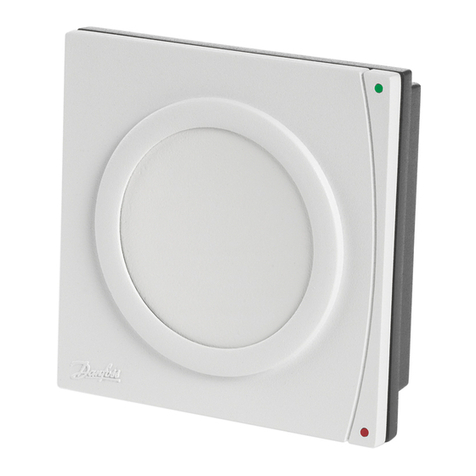
Danfoss
Danfoss ECL Comfort 110 installation guide

LevelOne
LevelOne WHG-1000 Quick installation guide
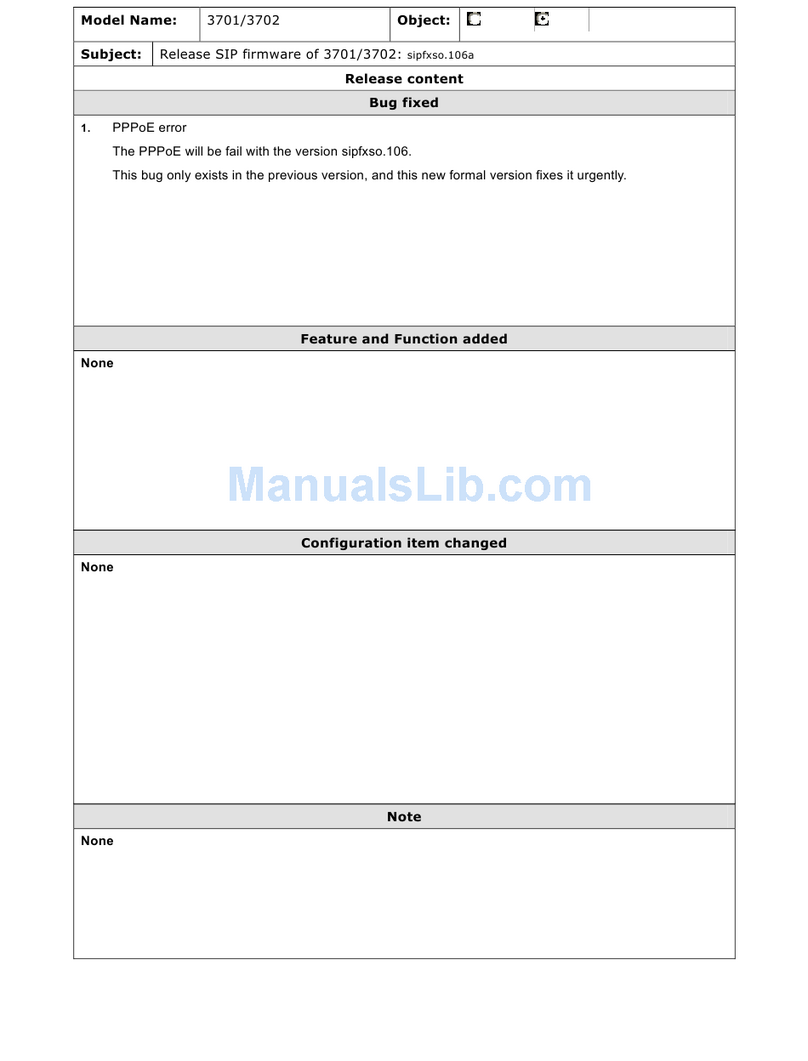
WELLTECH
WELLTECH 3701 - RELEASE NOTE V106A release note
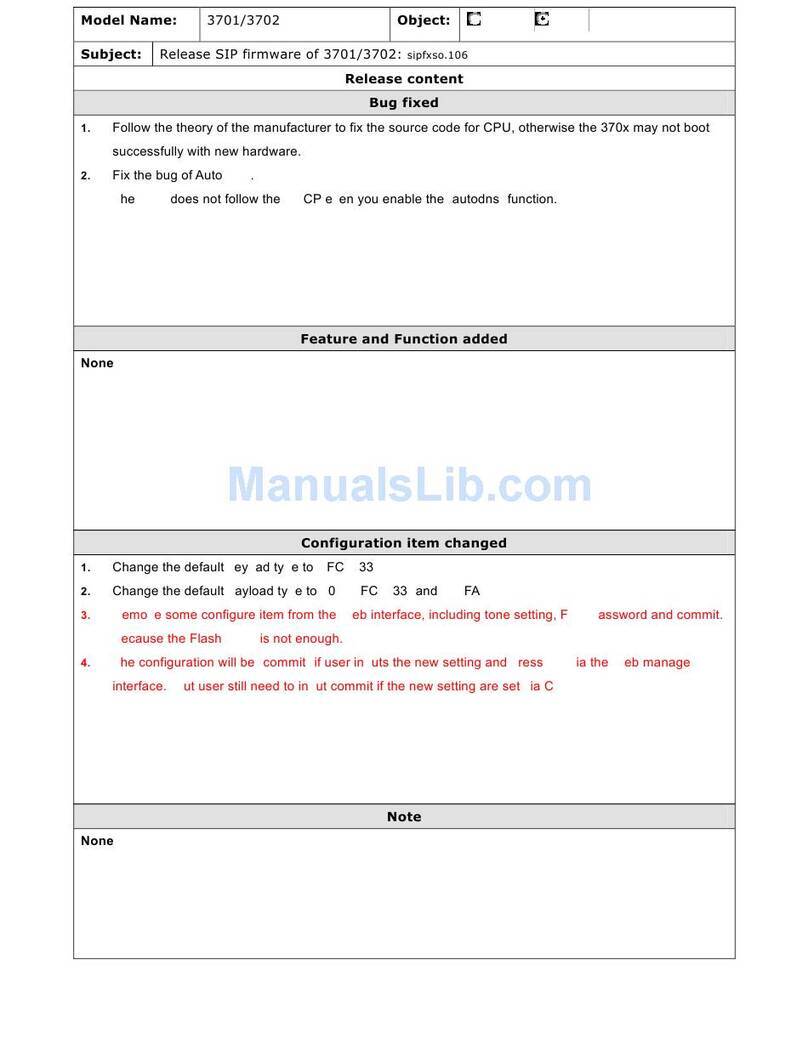
WELLTECH
WELLTECH 3701 - RELEASE NOTE V106 release note
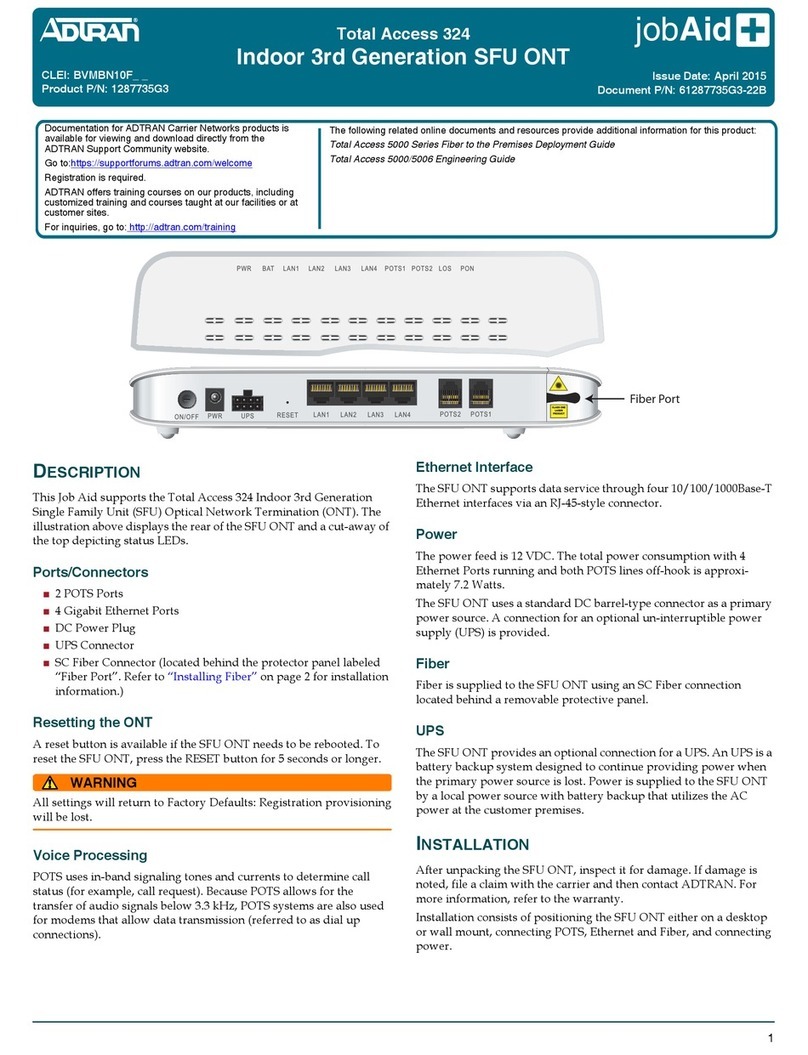
ADTRAN
ADTRAN jobAid+ Total Access 324 manual
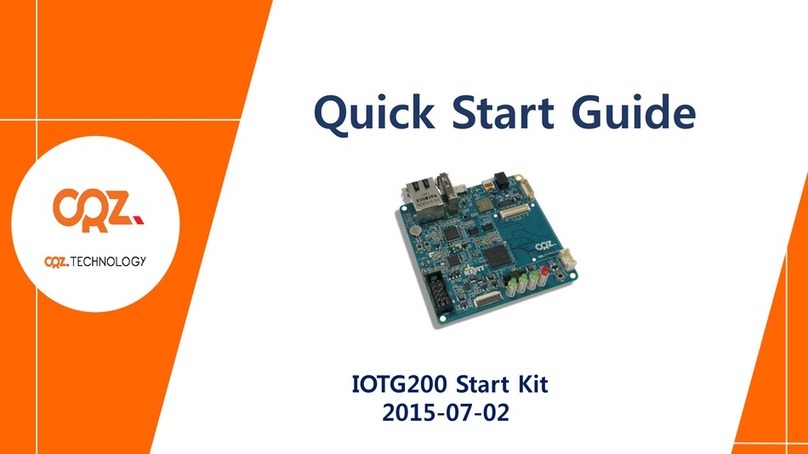
CRZ Technology
CRZ Technology IOTG200 Start Kit quick start guide
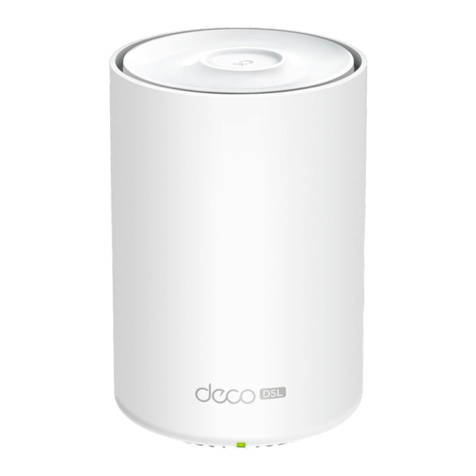
TP-Link
TP-Link Deco X50-DSL user guide
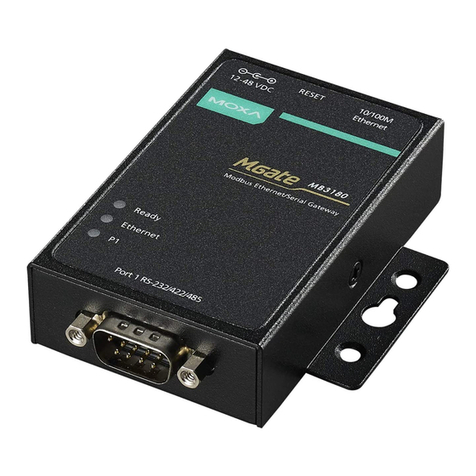
Moxa Technologies
Moxa Technologies MGate MB3180 Quick installation guide
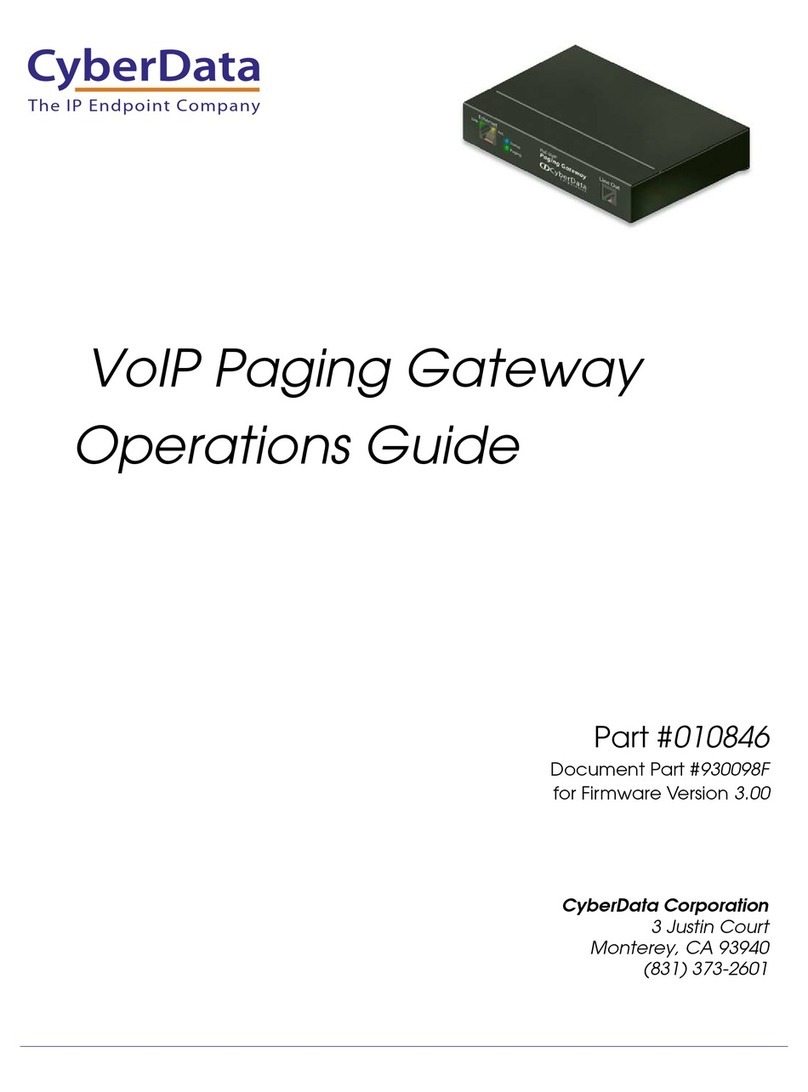
CyberData
CyberData SiP Compliant 010846 Operation guide
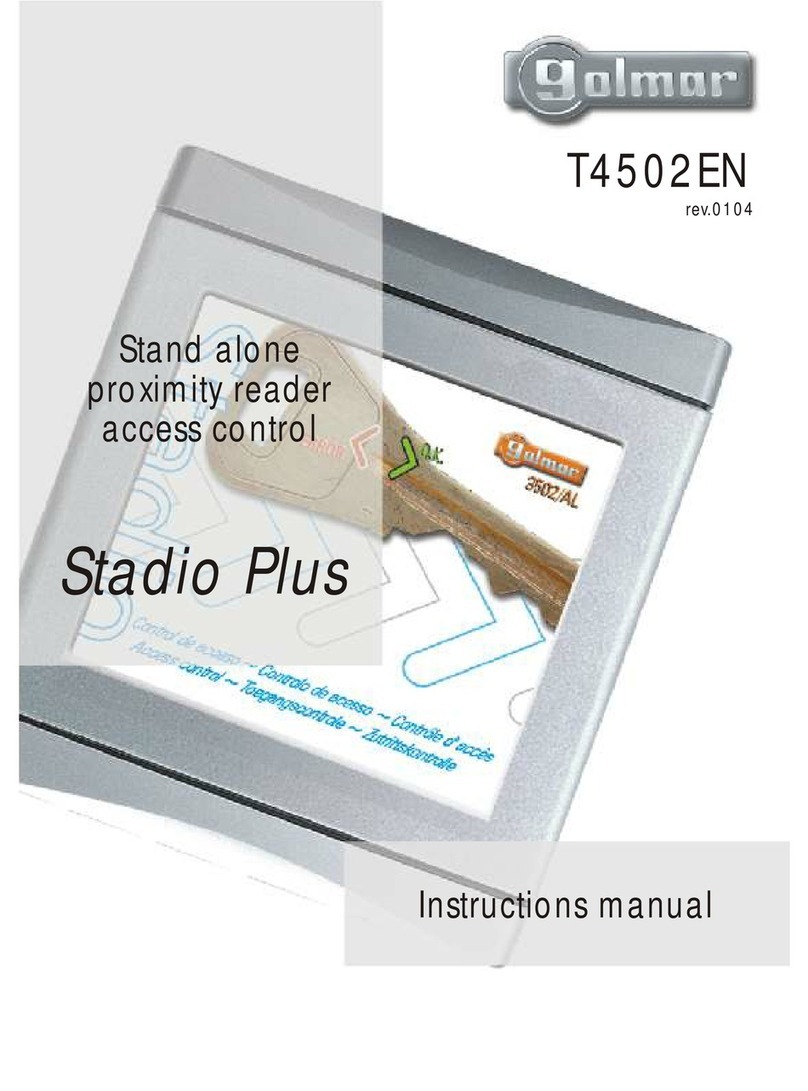
golmar
golmar Stadio Plus 4502/AL instruction manual
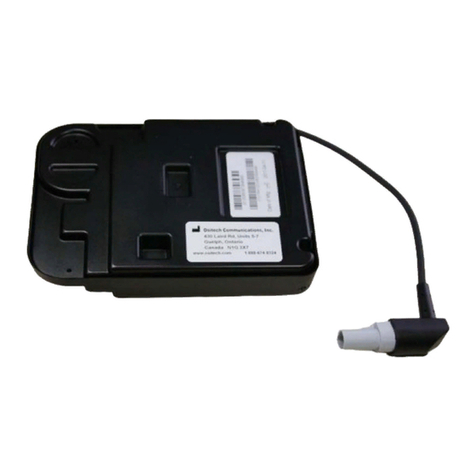
Ositech Communications
Ositech Communications Titan III Technical reference guide

Fife
Fife SBPC-21-EN Customer instruction manual
